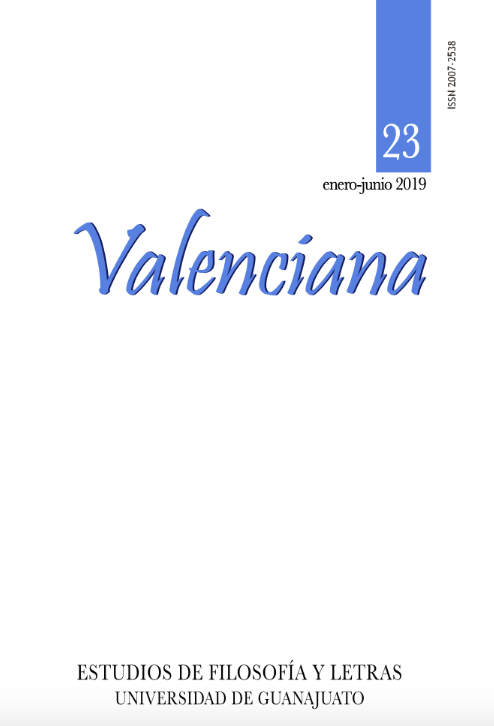The Other as Game —and as Disaster(Life in plastic, it’s fantastic: we are just getting started)
DOI:
https://doi.org/10.15174/rv.v0i23.426Abstract
In our paper we have presented the myth of Pygmalion as background of a reflection, in which we approach the question of the Other, building on the possibility of that the virtual Other “embodied” (in this case in a silicone Doll/Sexdoll) could replace and even supplant, in desire, the Other by itself. We will try to show that the dichotomies between live-dead, real-unreal or true-false are very insufficient to understand the question of “the Other”, because the figuration of this “Other” is more powerful and relevant in the field of imaginary than the ontic features of its direct and factual presence. The possibility, at least experimental possibility, of playing the “Other” is an enormous undertaking, insofar as it can sink into the disaster of an unlimited narcissism and a desperate loneliness, but it can also offer a therapeutic option, when certain circumstances arise (it is the case raised in the film Lars and the Real Girl). On the other hand, make a detour through the virtual Other allows us to prepare the basis for a far-reaching philosophical question, as long as it allows us to propose phenomenologically and dialectically the question of the Other. Basic material for this paper is a ZDF documentary for Arte-Channel entitled Traumfrauen, which shows the basic features of coexistence between Dean Bevan and his sexdolls.References
Bibliografía
AA. VV., 1997, Muñecos, Revista Sileno. Variaciones sobre arte y pensamiento 2, Madrid.
Cervantes Saavedra, Miguel de, 1998, Don Quijote de la Mancha, Nueva Edición anotada. Presentación y prólogo de Francisco Rico, Galaxia Gutenberg/Círculo de Lectores., Barcelona.
García Calvente, Pablo, 2018, “Helmut Newton y el maniquí: la ambigüedad de lo artificial”, en Cuadernos de Arte de la Universidad de Granada, 49: 1-16. file:///C:/Users/Usuario/Desktop/newton%20maniquies.pdf
Heidegger, Martin, 2016, Ser y tiempo, Trotta, Madrid.
Kundera, Milan, 1987, El arte de la novela, Tusquets, Barcelona.
Lévinas, Emmanuel, 1977, Totalidad e infinito. Ensayo sobre la exterioridad, Sígueme, Salamanca.
Moreno, César, 1989, La intención comunicativa. Ontología e intersubjegividad en la fenomenología de Husserl, Thémata, Sevilla.
_______, 1997, “El cuerpo desalmado, o ´por lo que parece un cuerpo´”, en Sileno. Variaciones sobre arte y pensamiento 2, 21-30.
_______, 1998, Tráfico de almas. Ensayo sobre el deseo de alteridad, Pre-textos, Valencia.
_______, 2001, “Deseo de realidad. Un fragmento (autobiográfico) de mi Discurso del método”, en AA.VV., Que piensen ellos, Opera Prima, Madrid, 127-140.
_______, 2004-1, “El Otro-máquina”, en el vol. col. (P. Martínez Freire, J.V. Arregui, J.A. García González y M.V. Padilla, eds.), Cuerpos, subjetividades y artefactos, Reprodigital, Granada, 111-122.
________, 2004-2, “Vértigo de la posibilidad, complejidad y axiología”, en Escritos de Filosofía (Buenos Aires) 44, 139-162.
Ovidio Nason, Publio, 1995, Metamorfosis (ed. y trad. de Consuelo Alvarez y Rosa Mª Iglesias), Cátedra, Madrid.
Ortega y Gasset, José, 1983, “El hombre y la gente”, en Obras completas, VII, Alianza Editorial/Revista de Occidente.
Pedraza, Pilar 1998, Máquinas de amar. Secretos del cuerpo artificial, Valdemar, Madrid.
Perniola, Mario, 1998, El sex-appeal de lo inorgánico, Trama Editorial, Madrid.
Rueda, Ana, 1998, Pigmalión y Galatea. Refracciones modernas de un mito, Fundamentos (Espiral Hispanoamericana), Caracas.
Sartre, Jean-Paul, 1976, El ser y la nada. Ensayo de ontología fenomenológica, Losada, Buenos Aires.
Material audiovisual
Aqua, 1997: Barbie Girl, en el álbum Aquarium, Universal Music https://www.youtube.com/watch?v=ZyhrYis509A (Videoclip)
Bäckmann, Claudia, y Pöthke, Cristoph, 2018, Traumfrauen aus Silikon. Wenn Männer Puppe lieben / Jolie Poupée. Quand les hommes préfèrent la silicone, ZDF, Canal Arte, https://www.arte.tv/es/videos/079474-007-A/cuando-los-hombres-prefieren-munecas-de-silicona/
Published
How to Cite
Issue
Section
License
Author(s) who publish in this journal do accept the next conditions:
According to copyright regulations, Valenciana does recognize and respect the authors’ moral right, as well as the right of property, which will be assigned to the journal for its diffusion in open access.
Valenciana does not charge authors for the submission, editorial process or publication in the journal.
All texts published and distributed by Valenciana (without exception) are supported by the license Creative Commons Attribution-NonCommercial 4.0 International (CC BY-NC 4.0), which allows third parties to use the publication as long as they mention the author and the first publication.
Authors can make other independent and additional contractual agreements for the non-exclusive use of his article published in Valenciana (e.g. including it in an institutional repository or in printed/electronic media), as long as it is explicitly clarified that the article was published for the first time in this journal.
For these purposes, authors must sign and send the letter of submission and copyright transfer form in a PDF file to this email address: revistavalenciana@gmail.com
This journal is under a license by Creative Commons Atribución-NoComercial-SinDerivadas 4.0 Internacional (CC BY-NC-ND 4.0)).











